Advantages and Disadvantages of Social Networking in Business
VerifiedAdded on 2020/03/02
|13
|2974
|123
Report
AI Summary
This report delves into the multifaceted impact of social networking on modern business practices. It begins by outlining the pervasive influence of social media platforms like Facebook, LinkedIn, and others, highlighting their significance in contemporary life and commerce. The report's objective is to analyze the advantages that social networking offers to businesses, such as enhanced brand awareness, targeted marketing capabilities, competitor monitoring, lead generation, cost-effectiveness, and improved customer service. Simultaneously, it addresses the disadvantages, including the time-intensive nature of social media management, challenges related to copyrights and trademarks, privacy and security concerns, and the lack of control over user feedback. The report synthesizes existing literature to provide a comprehensive overview of social networking's role in business strategy, emphasizing the need for businesses to carefully consider both the opportunities and the risks associated with leveraging social media platforms for marketing and customer engagement.
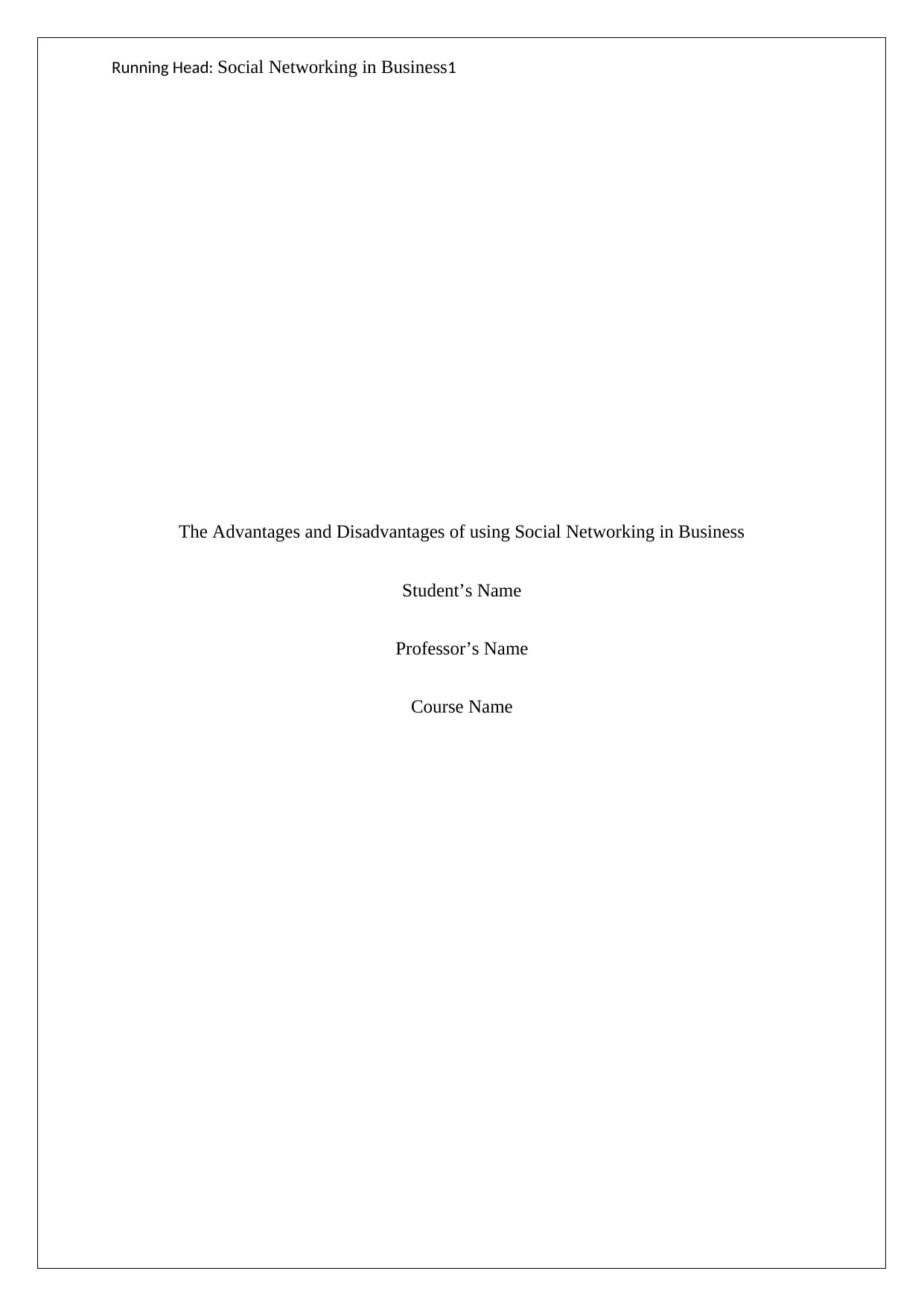
Running Head: Social Networking in Business1
The Advantages and Disadvantages of using Social Networking in Business
Student’s Name
Professor’s Name
Course Name
The Advantages and Disadvantages of using Social Networking in Business
Student’s Name
Professor’s Name
Course Name
Paraphrase This Document
Need a fresh take? Get an instant paraphrase of this document with our AI Paraphraser

Running Head: Social Networking in Business 2
Table of Contents
Introduction: Social Networking in Business 3
Project Objective 3
Project Scope 3
Literature Review 4
Advantages 5
Disadvantages 7
Conclusion 9
Table of Contents
Introduction: Social Networking in Business 3
Project Objective 3
Project Scope 3
Literature Review 4
Advantages 5
Disadvantages 7
Conclusion 9
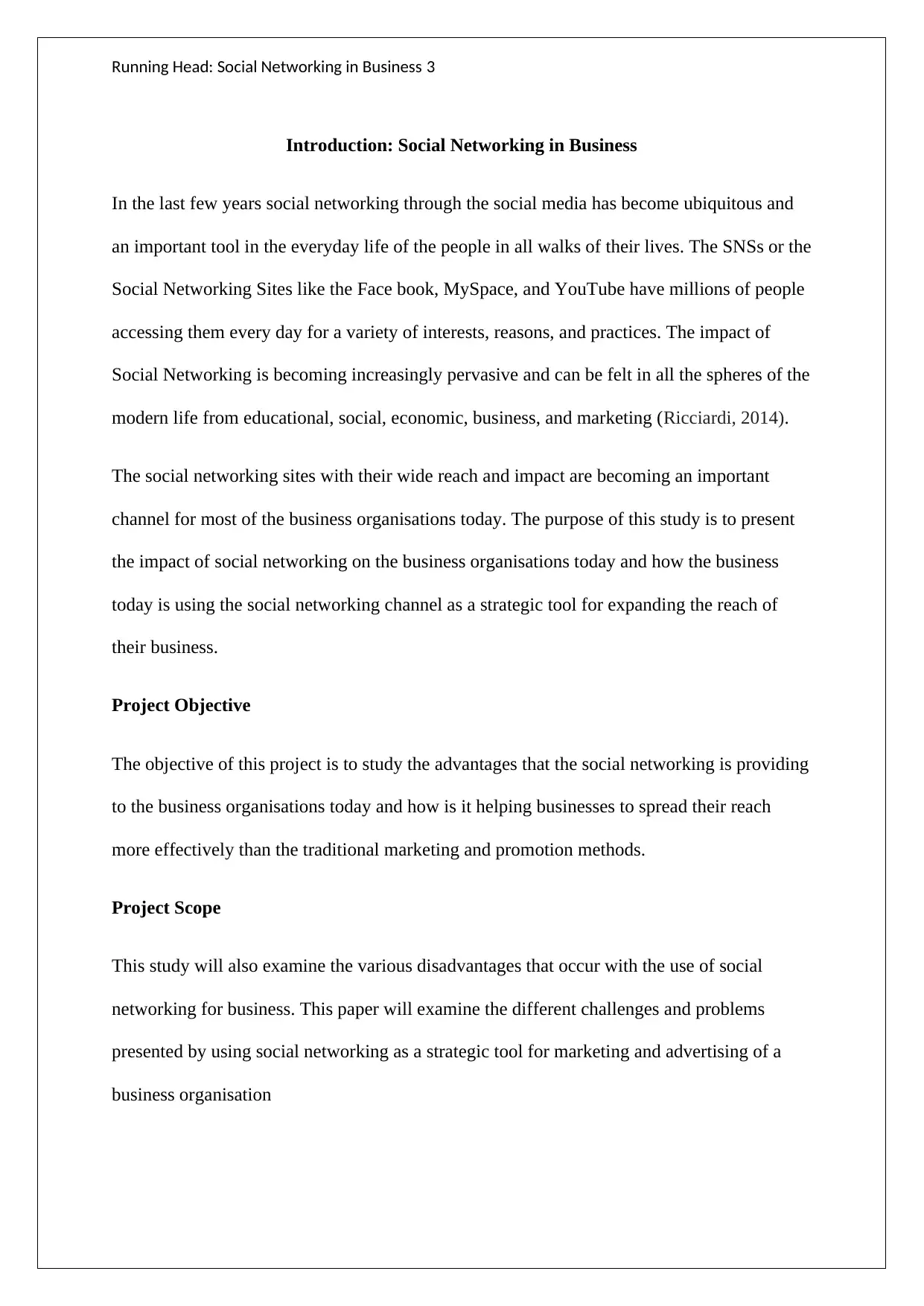
Running Head: Social Networking in Business 3
Introduction: Social Networking in Business
In the last few years social networking through the social media has become ubiquitous and
an important tool in the everyday life of the people in all walks of their lives. The SNSs or the
Social Networking Sites like the Face book, MySpace, and YouTube have millions of people
accessing them every day for a variety of interests, reasons, and practices. The impact of
Social Networking is becoming increasingly pervasive and can be felt in all the spheres of the
modern life from educational, social, economic, business, and marketing (Ricciardi, 2014).
The social networking sites with their wide reach and impact are becoming an important
channel for most of the business organisations today. The purpose of this study is to present
the impact of social networking on the business organisations today and how the business
today is using the social networking channel as a strategic tool for expanding the reach of
their business.
Project Objective
The objective of this project is to study the advantages that the social networking is providing
to the business organisations today and how is it helping businesses to spread their reach
more effectively than the traditional marketing and promotion methods.
Project Scope
This study will also examine the various disadvantages that occur with the use of social
networking for business. This paper will examine the different challenges and problems
presented by using social networking as a strategic tool for marketing and advertising of a
business organisation
Introduction: Social Networking in Business
In the last few years social networking through the social media has become ubiquitous and
an important tool in the everyday life of the people in all walks of their lives. The SNSs or the
Social Networking Sites like the Face book, MySpace, and YouTube have millions of people
accessing them every day for a variety of interests, reasons, and practices. The impact of
Social Networking is becoming increasingly pervasive and can be felt in all the spheres of the
modern life from educational, social, economic, business, and marketing (Ricciardi, 2014).
The social networking sites with their wide reach and impact are becoming an important
channel for most of the business organisations today. The purpose of this study is to present
the impact of social networking on the business organisations today and how the business
today is using the social networking channel as a strategic tool for expanding the reach of
their business.
Project Objective
The objective of this project is to study the advantages that the social networking is providing
to the business organisations today and how is it helping businesses to spread their reach
more effectively than the traditional marketing and promotion methods.
Project Scope
This study will also examine the various disadvantages that occur with the use of social
networking for business. This paper will examine the different challenges and problems
presented by using social networking as a strategic tool for marketing and advertising of a
business organisation
⊘ This is a preview!⊘
Do you want full access?
Subscribe today to unlock all pages.

Trusted by 1+ million students worldwide

Running Head: Social Networking in Business 4
Literature Review
Social media networking has been in existence for a period less than two decades but has
gained widespread prominence in all segments of society. Social networking sites like
LinkedIn, Face book, MySpace, Twitter, Instagram, and much more have gained a following
of more than one billion users in just about a decade of their existence and the users continue
to grow in numbers every day (Social Media: What are the advantages and disadvantages of
social networking sites, 2016). The commercial value and potential of the social networking
became apparent to business leaders and soon the social networking became an integral part
of the marketing and advertising department of business organisations. While individuals use
the social networking to build personal relationships and personal interaction, the business
organisations consider them as platforms on which they can interact and communicate with
the existing and potential customers directly (Nadaraja, & Yazdanifard, 2013).
This presents a paradigm shift from the earlier used traditional methods of customer
interaction as the companies can connect to millions of customers at the same time with just
the click of a button. The prospective and the existing customers also make use of this
platform to gain more information about the company and their business practices in much
faster way. Any marketing strategy using the social networking sites has a reach that cuts
across borders and reaches a much wider horizon and can be accessed by anyone who has an
internet connection anywhere in the world. Social networking in business has many
advantages but at the same time like any other business strategy, it has some prominent
drawbacks or disadvantages which can have strong impacts on the business (Abrons, n.d.).
Literature Review
Social media networking has been in existence for a period less than two decades but has
gained widespread prominence in all segments of society. Social networking sites like
LinkedIn, Face book, MySpace, Twitter, Instagram, and much more have gained a following
of more than one billion users in just about a decade of their existence and the users continue
to grow in numbers every day (Social Media: What are the advantages and disadvantages of
social networking sites, 2016). The commercial value and potential of the social networking
became apparent to business leaders and soon the social networking became an integral part
of the marketing and advertising department of business organisations. While individuals use
the social networking to build personal relationships and personal interaction, the business
organisations consider them as platforms on which they can interact and communicate with
the existing and potential customers directly (Nadaraja, & Yazdanifard, 2013).
This presents a paradigm shift from the earlier used traditional methods of customer
interaction as the companies can connect to millions of customers at the same time with just
the click of a button. The prospective and the existing customers also make use of this
platform to gain more information about the company and their business practices in much
faster way. Any marketing strategy using the social networking sites has a reach that cuts
across borders and reaches a much wider horizon and can be accessed by anyone who has an
internet connection anywhere in the world. Social networking in business has many
advantages but at the same time like any other business strategy, it has some prominent
drawbacks or disadvantages which can have strong impacts on the business (Abrons, n.d.).
Paraphrase This Document
Need a fresh take? Get an instant paraphrase of this document with our AI Paraphraser
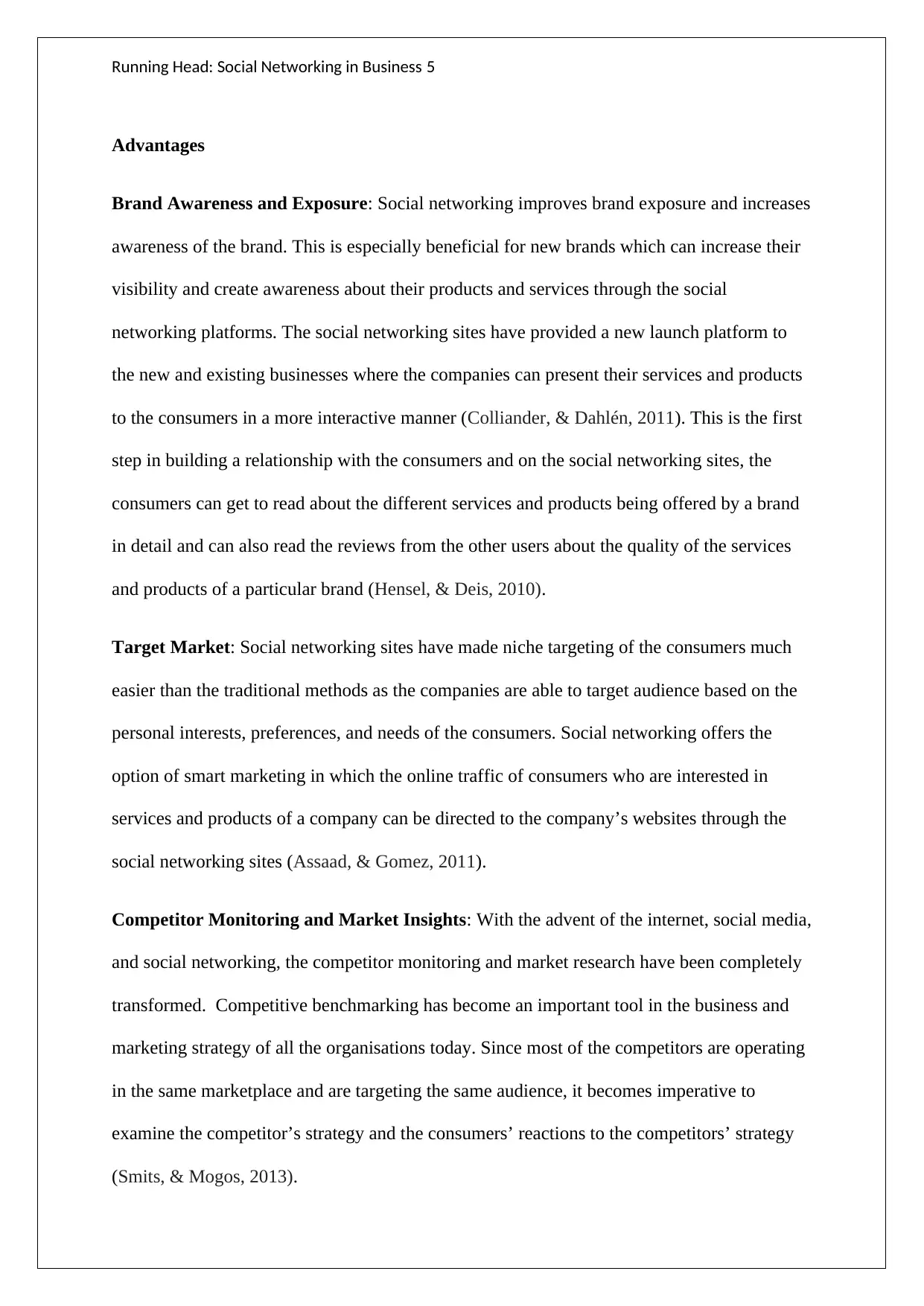
Running Head: Social Networking in Business 5
Advantages
Brand Awareness and Exposure: Social networking improves brand exposure and increases
awareness of the brand. This is especially beneficial for new brands which can increase their
visibility and create awareness about their products and services through the social
networking platforms. The social networking sites have provided a new launch platform to
the new and existing businesses where the companies can present their services and products
to the consumers in a more interactive manner (Colliander, & Dahlén, 2011). This is the first
step in building a relationship with the consumers and on the social networking sites, the
consumers can get to read about the different services and products being offered by a brand
in detail and can also read the reviews from the other users about the quality of the services
and products of a particular brand (Hensel, & Deis, 2010).
Target Market: Social networking sites have made niche targeting of the consumers much
easier than the traditional methods as the companies are able to target audience based on the
personal interests, preferences, and needs of the consumers. Social networking offers the
option of smart marketing in which the online traffic of consumers who are interested in
services and products of a company can be directed to the company’s websites through the
social networking sites (Assaad, & Gomez, 2011).
Competitor Monitoring and Market Insights: With the advent of the internet, social media,
and social networking, the competitor monitoring and market research have been completely
transformed. Competitive benchmarking has become an important tool in the business and
marketing strategy of all the organisations today. Since most of the competitors are operating
in the same marketplace and are targeting the same audience, it becomes imperative to
examine the competitor’s strategy and the consumers’ reactions to the competitors’ strategy
(Smits, & Mogos, 2013).
Advantages
Brand Awareness and Exposure: Social networking improves brand exposure and increases
awareness of the brand. This is especially beneficial for new brands which can increase their
visibility and create awareness about their products and services through the social
networking platforms. The social networking sites have provided a new launch platform to
the new and existing businesses where the companies can present their services and products
to the consumers in a more interactive manner (Colliander, & Dahlén, 2011). This is the first
step in building a relationship with the consumers and on the social networking sites, the
consumers can get to read about the different services and products being offered by a brand
in detail and can also read the reviews from the other users about the quality of the services
and products of a particular brand (Hensel, & Deis, 2010).
Target Market: Social networking sites have made niche targeting of the consumers much
easier than the traditional methods as the companies are able to target audience based on the
personal interests, preferences, and needs of the consumers. Social networking offers the
option of smart marketing in which the online traffic of consumers who are interested in
services and products of a company can be directed to the company’s websites through the
social networking sites (Assaad, & Gomez, 2011).
Competitor Monitoring and Market Insights: With the advent of the internet, social media,
and social networking, the competitor monitoring and market research have been completely
transformed. Competitive benchmarking has become an important tool in the business and
marketing strategy of all the organisations today. Since most of the competitors are operating
in the same marketplace and are targeting the same audience, it becomes imperative to
examine the competitor’s strategy and the consumers’ reactions to the competitors’ strategy
(Smits, & Mogos, 2013).
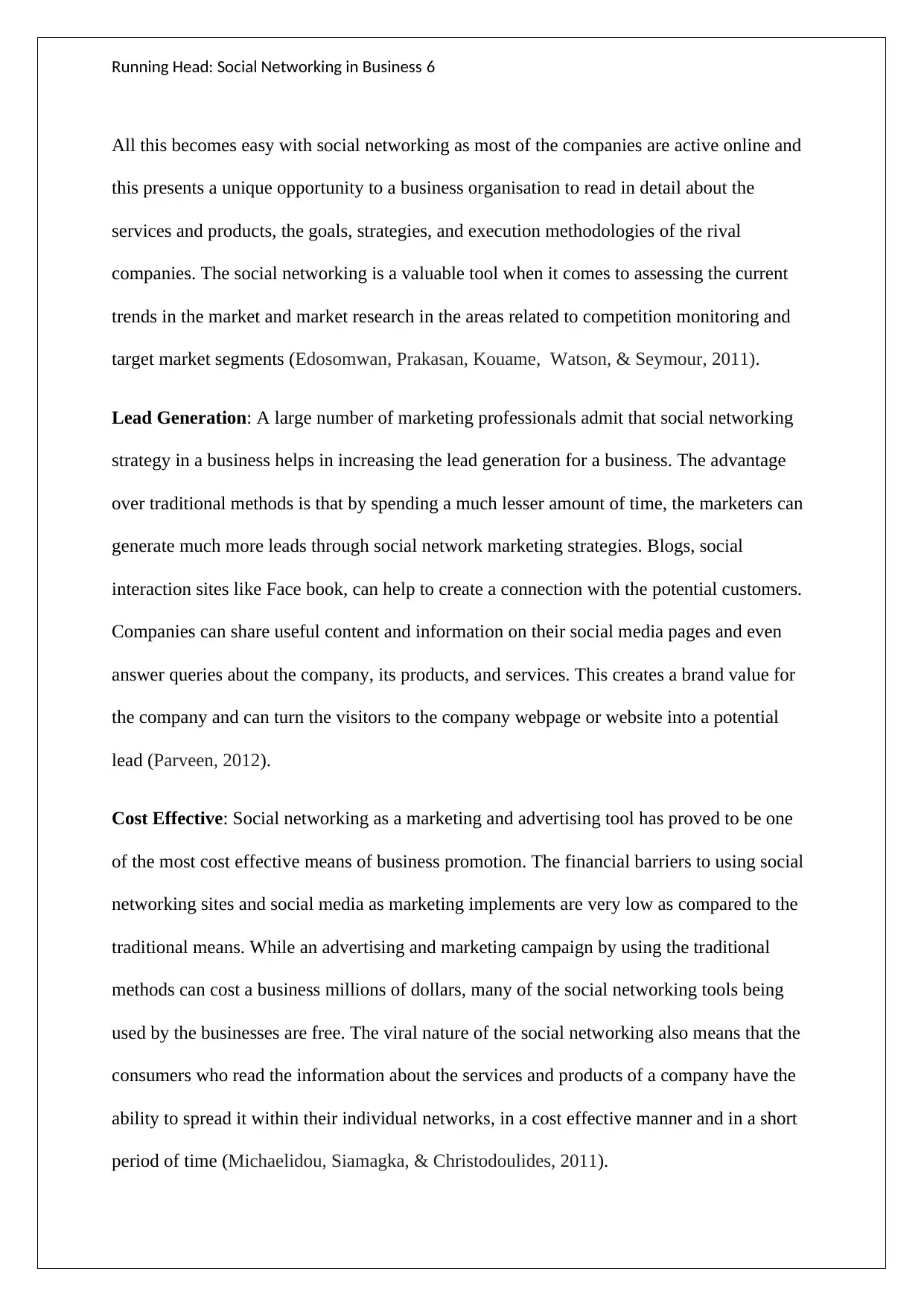
Running Head: Social Networking in Business 6
All this becomes easy with social networking as most of the companies are active online and
this presents a unique opportunity to a business organisation to read in detail about the
services and products, the goals, strategies, and execution methodologies of the rival
companies. The social networking is a valuable tool when it comes to assessing the current
trends in the market and market research in the areas related to competition monitoring and
target market segments (Edosomwan, Prakasan, Kouame, Watson, & Seymour, 2011).
Lead Generation: A large number of marketing professionals admit that social networking
strategy in a business helps in increasing the lead generation for a business. The advantage
over traditional methods is that by spending a much lesser amount of time, the marketers can
generate much more leads through social network marketing strategies. Blogs, social
interaction sites like Face book, can help to create a connection with the potential customers.
Companies can share useful content and information on their social media pages and even
answer queries about the company, its products, and services. This creates a brand value for
the company and can turn the visitors to the company webpage or website into a potential
lead (Parveen, 2012).
Cost Effective: Social networking as a marketing and advertising tool has proved to be one
of the most cost effective means of business promotion. The financial barriers to using social
networking sites and social media as marketing implements are very low as compared to the
traditional means. While an advertising and marketing campaign by using the traditional
methods can cost a business millions of dollars, many of the social networking tools being
used by the businesses are free. The viral nature of the social networking also means that the
consumers who read the information about the services and products of a company have the
ability to spread it within their individual networks, in a cost effective manner and in a short
period of time (Michaelidou, Siamagka, & Christodoulides, 2011).
All this becomes easy with social networking as most of the companies are active online and
this presents a unique opportunity to a business organisation to read in detail about the
services and products, the goals, strategies, and execution methodologies of the rival
companies. The social networking is a valuable tool when it comes to assessing the current
trends in the market and market research in the areas related to competition monitoring and
target market segments (Edosomwan, Prakasan, Kouame, Watson, & Seymour, 2011).
Lead Generation: A large number of marketing professionals admit that social networking
strategy in a business helps in increasing the lead generation for a business. The advantage
over traditional methods is that by spending a much lesser amount of time, the marketers can
generate much more leads through social network marketing strategies. Blogs, social
interaction sites like Face book, can help to create a connection with the potential customers.
Companies can share useful content and information on their social media pages and even
answer queries about the company, its products, and services. This creates a brand value for
the company and can turn the visitors to the company webpage or website into a potential
lead (Parveen, 2012).
Cost Effective: Social networking as a marketing and advertising tool has proved to be one
of the most cost effective means of business promotion. The financial barriers to using social
networking sites and social media as marketing implements are very low as compared to the
traditional means. While an advertising and marketing campaign by using the traditional
methods can cost a business millions of dollars, many of the social networking tools being
used by the businesses are free. The viral nature of the social networking also means that the
consumers who read the information about the services and products of a company have the
ability to spread it within their individual networks, in a cost effective manner and in a short
period of time (Michaelidou, Siamagka, & Christodoulides, 2011).
⊘ This is a preview!⊘
Do you want full access?
Subscribe today to unlock all pages.

Trusted by 1+ million students worldwide

Running Head: Social Networking in Business 7
Customer Service and Public Relations: Customer Service and public relations are the
other critical areas when it comes to using social networking for business. The customer
service department can get to interact with the consumers and the potential consumers on
almost a daily basis and can learn about the drawbacks, complaints, and grievances about
their products and services and provide effective and faster solutions to the consumers.
Similarly, social networking is a very effective tool for HR departments in supporting the
company’s recruitment system. Through the social networking sites like Linkedln a company
can build a professional network creating a talent pool and keep track of the performance of
prospective employees (Hanafizadeh, Ravasan, Nabavi, & Mehrabioun, 2012).
Disadvantages
Although social networking has offered a lot of new opportunities for business organisations,
it has certain risks and drawbacks that the marketing managers must keep in mind while
devising their business and marketing strategies.
Time Intensive: Social media and networking are interactive platforms where two-way
communication is important for success. While planning a marketing strategy on the social
networking platforms, the focus of the strategy is more developing long term relationships
which can be converted into sales figures. Therefore, dedicated personnel will have to be
devoted to the task of monitoring the social networks, answering the queries and questions,
and post the relevant product and service related information on the network. An organisation
which does not have dedicated professionals monitoring the social networking will not be
able to compete with others. Therefore, social media networking needs lots of time
investment and simply posting on a few social media sites will not get fruitful results for the
business (Oyza, & Edwin, 2015).
Customer Service and Public Relations: Customer Service and public relations are the
other critical areas when it comes to using social networking for business. The customer
service department can get to interact with the consumers and the potential consumers on
almost a daily basis and can learn about the drawbacks, complaints, and grievances about
their products and services and provide effective and faster solutions to the consumers.
Similarly, social networking is a very effective tool for HR departments in supporting the
company’s recruitment system. Through the social networking sites like Linkedln a company
can build a professional network creating a talent pool and keep track of the performance of
prospective employees (Hanafizadeh, Ravasan, Nabavi, & Mehrabioun, 2012).
Disadvantages
Although social networking has offered a lot of new opportunities for business organisations,
it has certain risks and drawbacks that the marketing managers must keep in mind while
devising their business and marketing strategies.
Time Intensive: Social media and networking are interactive platforms where two-way
communication is important for success. While planning a marketing strategy on the social
networking platforms, the focus of the strategy is more developing long term relationships
which can be converted into sales figures. Therefore, dedicated personnel will have to be
devoted to the task of monitoring the social networks, answering the queries and questions,
and post the relevant product and service related information on the network. An organisation
which does not have dedicated professionals monitoring the social networking will not be
able to compete with others. Therefore, social media networking needs lots of time
investment and simply posting on a few social media sites will not get fruitful results for the
business (Oyza, & Edwin, 2015).
Paraphrase This Document
Need a fresh take? Get an instant paraphrase of this document with our AI Paraphraser

Running Head: Social Networking in Business 8
Copyrights and Trademarks: It becomes an important exercise for the companies to protect
their copyrights and trademarks when they start operating on the social networking platforms.
The brand name of the company and the other intellectual property is just as valuable as the
other services and products of the company (Paquette, 2013). While the impromptu
communication and faster publicity may help the company in disseminating useful
information and copyrighted material to its target audience, the same facilities can be abused
by miscreants to abuse a firm’s copyrights and trademarks. The companies have to regularly
monitor their social networking platforms and also the social media being used by third-
parties to ensure that their intellectual property is not being misused in any manner. This kind
of impersonation can harm the company’s brand name and reputation if it is left unchecked or
undetected (Aral, Dellarocas, & Godes, 2013).
Privacy, Trust, and Security: Many of the consumers feel that social media marketing is
intrusive and invades their privacy. The users are also concerned about their personal
information being misused and fiascos related to the privacy concerns have led to major
criticisms of the public relations departments of many companies resulting into an erosion of
confidence in the company and a negative brand image. Trust in a brand name and the
company are very important in generating business on the social networking sites as there is
no personal interaction with another person while generating business and sharing
information. Therefore, companies while using the social networking sites should develop
stringent policies safeguarding the interests and privacy of the consumers.
Lack of Control on Feedback: The social networking sites can convert the potential
customers into viral advertisers and marketers for a company and this creates a pressure of
positive and negative feedback for the company. Depending on the way a company projects
itself online and the quality of services and products it offers to the customers, both positive
Copyrights and Trademarks: It becomes an important exercise for the companies to protect
their copyrights and trademarks when they start operating on the social networking platforms.
The brand name of the company and the other intellectual property is just as valuable as the
other services and products of the company (Paquette, 2013). While the impromptu
communication and faster publicity may help the company in disseminating useful
information and copyrighted material to its target audience, the same facilities can be abused
by miscreants to abuse a firm’s copyrights and trademarks. The companies have to regularly
monitor their social networking platforms and also the social media being used by third-
parties to ensure that their intellectual property is not being misused in any manner. This kind
of impersonation can harm the company’s brand name and reputation if it is left unchecked or
undetected (Aral, Dellarocas, & Godes, 2013).
Privacy, Trust, and Security: Many of the consumers feel that social media marketing is
intrusive and invades their privacy. The users are also concerned about their personal
information being misused and fiascos related to the privacy concerns have led to major
criticisms of the public relations departments of many companies resulting into an erosion of
confidence in the company and a negative brand image. Trust in a brand name and the
company are very important in generating business on the social networking sites as there is
no personal interaction with another person while generating business and sharing
information. Therefore, companies while using the social networking sites should develop
stringent policies safeguarding the interests and privacy of the consumers.
Lack of Control on Feedback: The social networking sites can convert the potential
customers into viral advertisers and marketers for a company and this creates a pressure of
positive and negative feedback for the company. Depending on the way a company projects
itself online and the quality of services and products it offers to the customers, both positive

Running Head: Social Networking in Business 9
and negative feedback can be generated for the company based on the individual experiences
of the consumers (Scott, 2015). The value of the consumer product-reviews, tags, and images
have increased manifold for the potential customers seeking feedback about the services and
products of a company. In many cases negative posts, disparaging comments and pictures can
damage the brand name of a company and because of the viral nature of the social media, the
companies at times cannot control the damaging effects of such negative publicity (Hajli,
2014).
Conclusion
In the present world dominated by social networking the consumers have assumed a new role
of content creators and are more proactive and functional customers than they were in the
past. While the social networking offers a plethora of opportunities to the new and existing
businesses, it also has some major drawbacks and risks associated with it. A company that
wants to utilise the social networking to expand its business should undertake a research on
the effective social media practices and should gain knowledge about the strategies of using
the social networking and social media as an efficacious tool in their business strategy (The
Advantages and Disadvantages of Social Media Marketing, n.d.).
and negative feedback can be generated for the company based on the individual experiences
of the consumers (Scott, 2015). The value of the consumer product-reviews, tags, and images
have increased manifold for the potential customers seeking feedback about the services and
products of a company. In many cases negative posts, disparaging comments and pictures can
damage the brand name of a company and because of the viral nature of the social media, the
companies at times cannot control the damaging effects of such negative publicity (Hajli,
2014).
Conclusion
In the present world dominated by social networking the consumers have assumed a new role
of content creators and are more proactive and functional customers than they were in the
past. While the social networking offers a plethora of opportunities to the new and existing
businesses, it also has some major drawbacks and risks associated with it. A company that
wants to utilise the social networking to expand its business should undertake a research on
the effective social media practices and should gain knowledge about the strategies of using
the social networking and social media as an efficacious tool in their business strategy (The
Advantages and Disadvantages of Social Media Marketing, n.d.).
⊘ This is a preview!⊘
Do you want full access?
Subscribe today to unlock all pages.

Trusted by 1+ million students worldwide
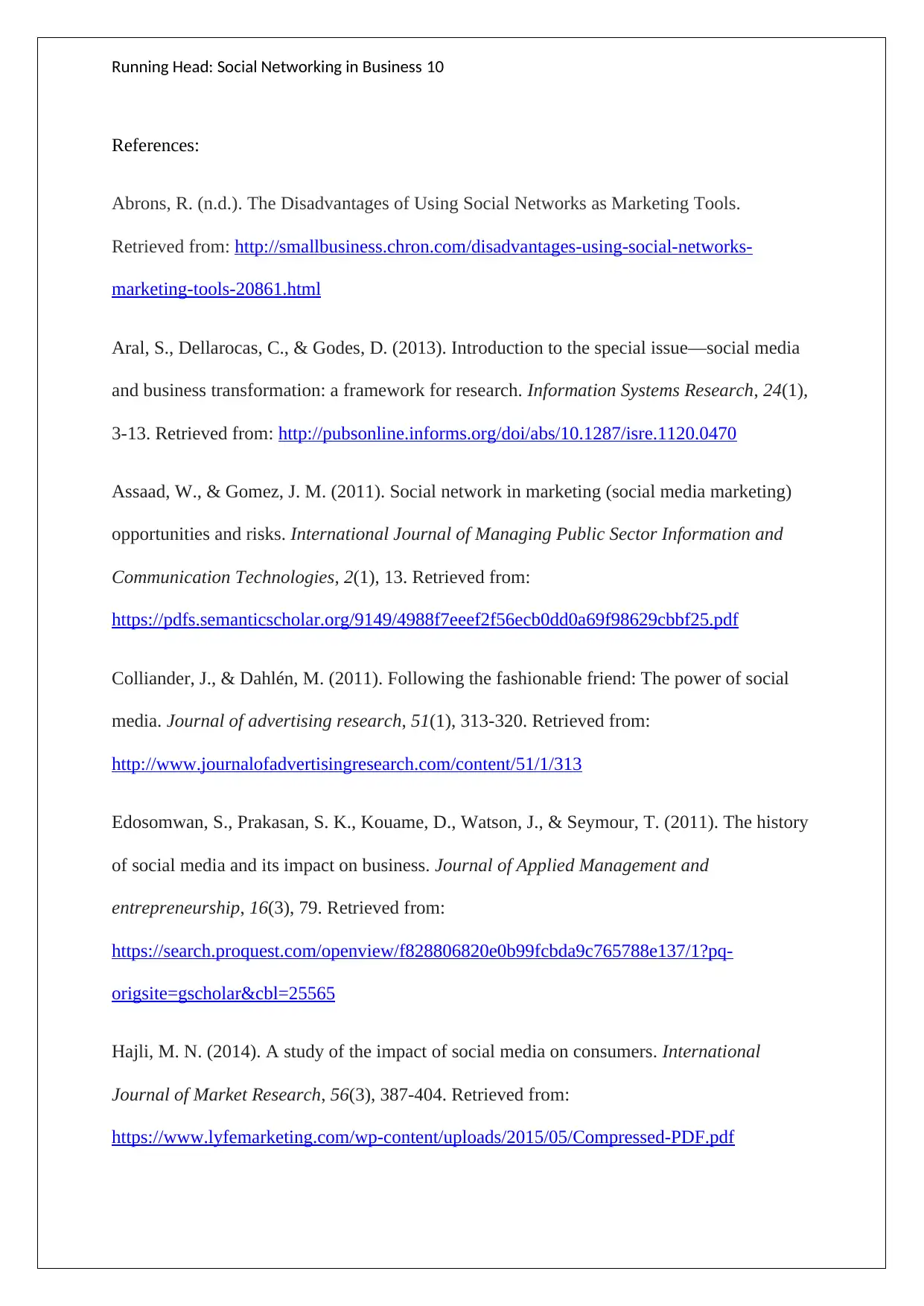
Running Head: Social Networking in Business 10
References:
Abrons, R. (n.d.). The Disadvantages of Using Social Networks as Marketing Tools.
Retrieved from: http://smallbusiness.chron.com/disadvantages-using-social-networks-
marketing-tools-20861.html
Aral, S., Dellarocas, C., & Godes, D. (2013). Introduction to the special issue—social media
and business transformation: a framework for research. Information Systems Research, 24(1),
3-13. Retrieved from: http://pubsonline.informs.org/doi/abs/10.1287/isre.1120.0470
Assaad, W., & Gomez, J. M. (2011). Social network in marketing (social media marketing)
opportunities and risks. International Journal of Managing Public Sector Information and
Communication Technologies, 2(1), 13. Retrieved from:
https://pdfs.semanticscholar.org/9149/4988f7eeef2f56ecb0dd0a69f98629cbbf25.pdf
Colliander, J., & Dahlén, M. (2011). Following the fashionable friend: The power of social
media. Journal of advertising research, 51(1), 313-320. Retrieved from:
http://www.journalofadvertisingresearch.com/content/51/1/313
Edosomwan, S., Prakasan, S. K., Kouame, D., Watson, J., & Seymour, T. (2011). The history
of social media and its impact on business. Journal of Applied Management and
entrepreneurship, 16(3), 79. Retrieved from:
https://search.proquest.com/openview/f828806820e0b99fcbda9c765788e137/1?pq-
origsite=gscholar&cbl=25565
Hajli, M. N. (2014). A study of the impact of social media on consumers. International
Journal of Market Research, 56(3), 387-404. Retrieved from:
https://www.lyfemarketing.com/wp-content/uploads/2015/05/Compressed-PDF.pdf
References:
Abrons, R. (n.d.). The Disadvantages of Using Social Networks as Marketing Tools.
Retrieved from: http://smallbusiness.chron.com/disadvantages-using-social-networks-
marketing-tools-20861.html
Aral, S., Dellarocas, C., & Godes, D. (2013). Introduction to the special issue—social media
and business transformation: a framework for research. Information Systems Research, 24(1),
3-13. Retrieved from: http://pubsonline.informs.org/doi/abs/10.1287/isre.1120.0470
Assaad, W., & Gomez, J. M. (2011). Social network in marketing (social media marketing)
opportunities and risks. International Journal of Managing Public Sector Information and
Communication Technologies, 2(1), 13. Retrieved from:
https://pdfs.semanticscholar.org/9149/4988f7eeef2f56ecb0dd0a69f98629cbbf25.pdf
Colliander, J., & Dahlén, M. (2011). Following the fashionable friend: The power of social
media. Journal of advertising research, 51(1), 313-320. Retrieved from:
http://www.journalofadvertisingresearch.com/content/51/1/313
Edosomwan, S., Prakasan, S. K., Kouame, D., Watson, J., & Seymour, T. (2011). The history
of social media and its impact on business. Journal of Applied Management and
entrepreneurship, 16(3), 79. Retrieved from:
https://search.proquest.com/openview/f828806820e0b99fcbda9c765788e137/1?pq-
origsite=gscholar&cbl=25565
Hajli, M. N. (2014). A study of the impact of social media on consumers. International
Journal of Market Research, 56(3), 387-404. Retrieved from:
https://www.lyfemarketing.com/wp-content/uploads/2015/05/Compressed-PDF.pdf
Paraphrase This Document
Need a fresh take? Get an instant paraphrase of this document with our AI Paraphraser
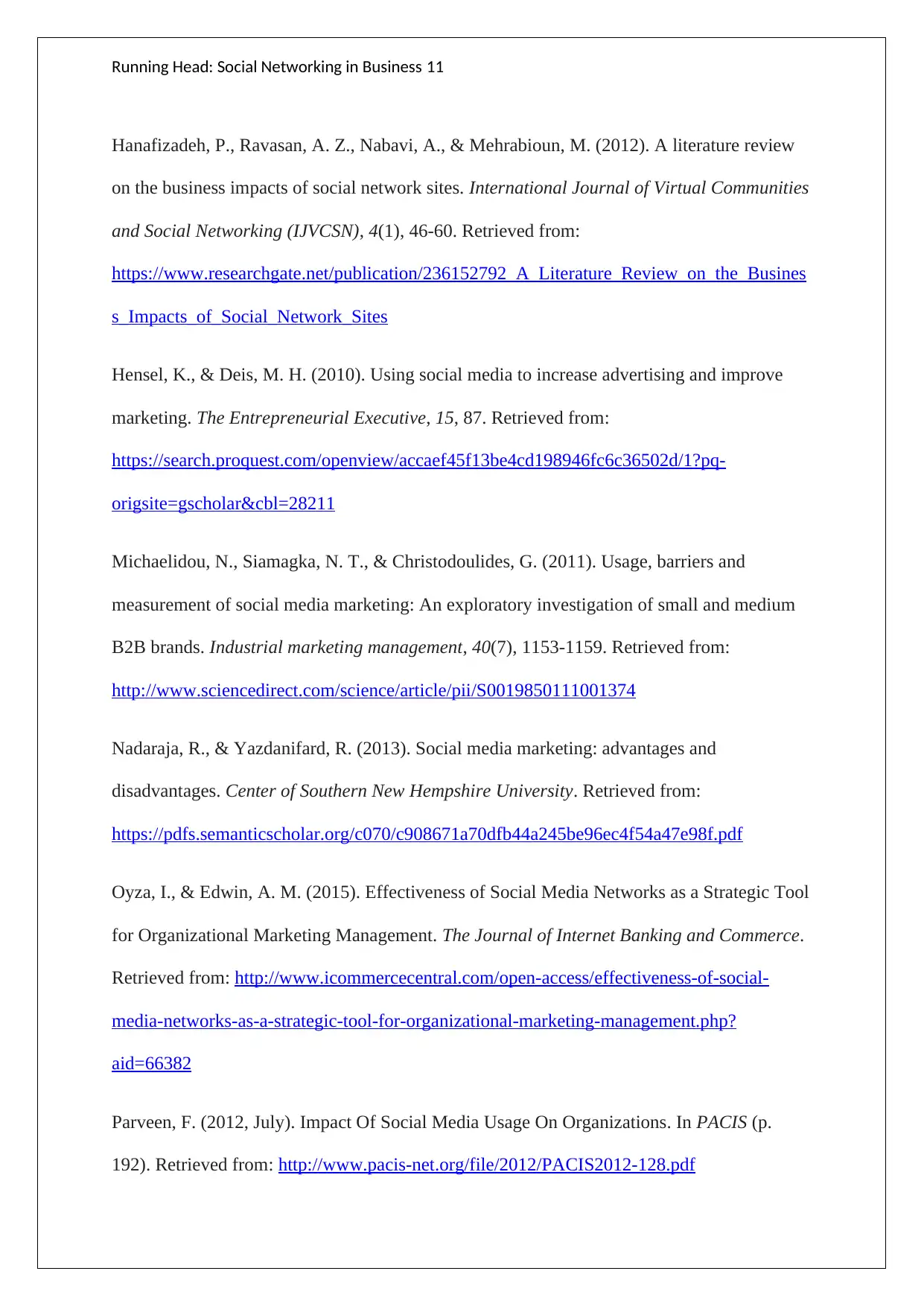
Running Head: Social Networking in Business 11
Hanafizadeh, P., Ravasan, A. Z., Nabavi, A., & Mehrabioun, M. (2012). A literature review
on the business impacts of social network sites. International Journal of Virtual Communities
and Social Networking (IJVCSN), 4(1), 46-60. Retrieved from:
https://www.researchgate.net/publication/236152792_A_Literature_Review_on_the_Busines
s_Impacts_of_Social_Network_Sites
Hensel, K., & Deis, M. H. (2010). Using social media to increase advertising and improve
marketing. The Entrepreneurial Executive, 15, 87. Retrieved from:
https://search.proquest.com/openview/accaef45f13be4cd198946fc6c36502d/1?pq-
origsite=gscholar&cbl=28211
Michaelidou, N., Siamagka, N. T., & Christodoulides, G. (2011). Usage, barriers and
measurement of social media marketing: An exploratory investigation of small and medium
B2B brands. Industrial marketing management, 40(7), 1153-1159. Retrieved from:
http://www.sciencedirect.com/science/article/pii/S0019850111001374
Nadaraja, R., & Yazdanifard, R. (2013). Social media marketing: advantages and
disadvantages. Center of Southern New Hempshire University. Retrieved from:
https://pdfs.semanticscholar.org/c070/c908671a70dfb44a245be96ec4f54a47e98f.pdf
Oyza, I., & Edwin, A. M. (2015). Effectiveness of Social Media Networks as a Strategic Tool
for Organizational Marketing Management. The Journal of Internet Banking and Commerce.
Retrieved from: http://www.icommercecentral.com/open-access/effectiveness-of-social-
media-networks-as-a-strategic-tool-for-organizational-marketing-management.php?
aid=66382
Parveen, F. (2012, July). Impact Of Social Media Usage On Organizations. In PACIS (p.
192). Retrieved from: http://www.pacis-net.org/file/2012/PACIS2012-128.pdf
Hanafizadeh, P., Ravasan, A. Z., Nabavi, A., & Mehrabioun, M. (2012). A literature review
on the business impacts of social network sites. International Journal of Virtual Communities
and Social Networking (IJVCSN), 4(1), 46-60. Retrieved from:
https://www.researchgate.net/publication/236152792_A_Literature_Review_on_the_Busines
s_Impacts_of_Social_Network_Sites
Hensel, K., & Deis, M. H. (2010). Using social media to increase advertising and improve
marketing. The Entrepreneurial Executive, 15, 87. Retrieved from:
https://search.proquest.com/openview/accaef45f13be4cd198946fc6c36502d/1?pq-
origsite=gscholar&cbl=28211
Michaelidou, N., Siamagka, N. T., & Christodoulides, G. (2011). Usage, barriers and
measurement of social media marketing: An exploratory investigation of small and medium
B2B brands. Industrial marketing management, 40(7), 1153-1159. Retrieved from:
http://www.sciencedirect.com/science/article/pii/S0019850111001374
Nadaraja, R., & Yazdanifard, R. (2013). Social media marketing: advantages and
disadvantages. Center of Southern New Hempshire University. Retrieved from:
https://pdfs.semanticscholar.org/c070/c908671a70dfb44a245be96ec4f54a47e98f.pdf
Oyza, I., & Edwin, A. M. (2015). Effectiveness of Social Media Networks as a Strategic Tool
for Organizational Marketing Management. The Journal of Internet Banking and Commerce.
Retrieved from: http://www.icommercecentral.com/open-access/effectiveness-of-social-
media-networks-as-a-strategic-tool-for-organizational-marketing-management.php?
aid=66382
Parveen, F. (2012, July). Impact Of Social Media Usage On Organizations. In PACIS (p.
192). Retrieved from: http://www.pacis-net.org/file/2012/PACIS2012-128.pdf

Running Head: Social Networking in Business 12
Paquette, H. (2013). Social media as a marketing tool: A literature review. Retrieved from:
http://digitalcommons.uri.edu/cgi/viewcontent.cgi?article=1001&context=tmd_major_papers
Ricciardi, F. (2014). Business Networking: Possible Positive and Negative Impacts on
Innovation and Excellence. In Innovation Processes in Business Networks (pp. 5-15).
Springer Fachmedien Wiesbaden. Retrieved from:
https://link.springer.com/chapter/10.1007/978-3-658-03439-9_2
Scott, D. M. (2015). The new rules of marketing and PR: How to use social media, online
video, mobile applications, blogs, news releases, and viral marketing to reach buyers
directly. John Wiley & Sons. Retrieved from: https://books.google.co.in/books?
hl=en&lr=&id=gi5ECgAAQBAJ&oi=fnd&pg=PR19&dq=EFFECTIVENESS+OF+THE+U
SE+OF+SOCIAL+MEDIA+marketing+and+advertising+in+business+and+trade&ots=DjUQ
MD6d1g&sig=JGbpwoGU3hZhxLHUO0KEuVdmYiA#v=onepage&q&f=false
Smits, M., & Mogos, S. (2013). The Impact Of Social Media On Business Performance.
In ECIS (p. 125). Retrieved from: http://aisel.aisnet.org/cgi/viewcontent.cgi?
article=1348&context=ecis2013_cr
Social Media: What are the advantages and disadvantages of social networking sites? (2016,
June 01). Retrieved from: https://www.shrm.org/ResourcesAndTools/tools-and-samples/hr-
qa/Pages/socialnetworkingsitespolicy.aspx
The Advantages and Disadvantages of Social Media Marketing. (n.d.). Retrieved from:
https://www.webpagefx.com/internet-marketing/social-media-marketing-advantages-and-
disadvantages.html
Paquette, H. (2013). Social media as a marketing tool: A literature review. Retrieved from:
http://digitalcommons.uri.edu/cgi/viewcontent.cgi?article=1001&context=tmd_major_papers
Ricciardi, F. (2014). Business Networking: Possible Positive and Negative Impacts on
Innovation and Excellence. In Innovation Processes in Business Networks (pp. 5-15).
Springer Fachmedien Wiesbaden. Retrieved from:
https://link.springer.com/chapter/10.1007/978-3-658-03439-9_2
Scott, D. M. (2015). The new rules of marketing and PR: How to use social media, online
video, mobile applications, blogs, news releases, and viral marketing to reach buyers
directly. John Wiley & Sons. Retrieved from: https://books.google.co.in/books?
hl=en&lr=&id=gi5ECgAAQBAJ&oi=fnd&pg=PR19&dq=EFFECTIVENESS+OF+THE+U
SE+OF+SOCIAL+MEDIA+marketing+and+advertising+in+business+and+trade&ots=DjUQ
MD6d1g&sig=JGbpwoGU3hZhxLHUO0KEuVdmYiA#v=onepage&q&f=false
Smits, M., & Mogos, S. (2013). The Impact Of Social Media On Business Performance.
In ECIS (p. 125). Retrieved from: http://aisel.aisnet.org/cgi/viewcontent.cgi?
article=1348&context=ecis2013_cr
Social Media: What are the advantages and disadvantages of social networking sites? (2016,
June 01). Retrieved from: https://www.shrm.org/ResourcesAndTools/tools-and-samples/hr-
qa/Pages/socialnetworkingsitespolicy.aspx
The Advantages and Disadvantages of Social Media Marketing. (n.d.). Retrieved from:
https://www.webpagefx.com/internet-marketing/social-media-marketing-advantages-and-
disadvantages.html
⊘ This is a preview!⊘
Do you want full access?
Subscribe today to unlock all pages.

Trusted by 1+ million students worldwide
1 out of 13
Related Documents
Your All-in-One AI-Powered Toolkit for Academic Success.
+13062052269
info@desklib.com
Available 24*7 on WhatsApp / Email
![[object Object]](/_next/static/media/star-bottom.7253800d.svg)
Unlock your academic potential
Copyright © 2020–2025 A2Z Services. All Rights Reserved. Developed and managed by ZUCOL.




